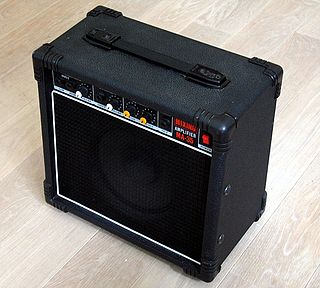
Roland Corporation is a Japanese multinational manufacturer of electronic musical instruments, electronic equipment, and software. It was founded by Ikutaro Kakehashi in Osaka on 18 April 1972. In 2005, its headquarters relocated to Hamamatsu in Shizuoka Prefecture. It has factories in Malaysia, Taiwan, Japan, and the United States. As of December 2022, it employed 2,783 people. In 2014, it was subject to a management buyout by its CEO, Junichi Miki, supported by Taiyo Pacific Partners.

An instrument amplifier is an electronic device that converts the often barely audible or purely electronic signal of a musical instrument into a larger electronic signal to feed to a loudspeaker. An instrument amplifier is used with musical instruments such as an electric guitar, an electric bass, electric organ, electric piano, synthesizers and drum machine to convert the signal from the pickup or other sound source into an electronic signal that has enough power, due to being routed through a power amplifier, capable of driving one or more loudspeaker that can be heard by the performers and audience.

A guitar amplifier is an electronic device or system that strengthens the electrical signal from a pickup on an electric guitar, bass guitar, or acoustic guitar so that it can produce sound through one or more loudspeakers, which are typically housed in a wooden cabinet. A guitar amplifier may be a standalone wood or metal cabinet that contains only the power amplifier circuits, requiring the use of a separate speaker cabinet–or it may be a "combo" amplifier, which contains both the amplifier and one or more speakers in a wooden cabinet. There is a wide range of sizes and power ratings for guitar amplifiers, from small, lightweight "practice amplifiers" with a single 6-inch speaker and a 10-watt amp to heavy combo amps with four 10-inch or four 12-inch speakers and a 100-watt amplifier, which are loud enough to use in a nightclub or bar performance.
Boss is a manufacturer of effects pedals for electric guitar and bass guitar. It is a division of the Roland Corporation, a Japanese manufacturer that specializes in musical equipment and accessories. For many years Boss has manufactured a wide range of products related to effects processing for guitars, including "compact" and "twin" effects pedals, multi-effect pedals, electronic tuners and pedal boards. In more recent times, Boss expanded their product range by including digital studios, rhythm machines, samplers and other electronic music equipment. They also are now manufacturing solid-state amplifiers and speaker heads such as the Waza and the Katana. Both feature multi-effects units meant to emulate Boss' classic effects pedals.

Peavey Electronics Corporation is an American company which designs, develops, manufactures and markets professional audio equipment. It is one of the largest audio equipment manufacturers in the world, and is headquartered in Meridian, Mississippi.

Marshall Amplification is a British company that designs and manufactures music amplifiers and speaker cabinets. It was founded in London by drum shop owner and drummer, Jim Marshall, and is based in Bletchley, Milton Keynes, England. Since March 2023, Marshall Amplification is a division of the Marshall Group, a Swedish company based in Stockholm. The group has other divisions that use the Marshall brand.

Scholz Research & Development, Inc. was the name of the company founded by musician and engineer Tom Scholz to design and manufacture music technology products.

The Roland Bolt 30/60/100 was the only line of tube guitar amplifiers produced by Roland. The amplifier was launched in the market in 1979 when the Roland company was trying to pursue the success of the Mesa Boogie Mark amplifiers.
Chorus is an audio effect that occurs when individual sounds with approximately the same time, and very similar pitches, converge. While similar sounds coming from multiple sources can occur naturally, as in the case of a choir or string orchestra, it can also be simulated using an electronic effects unit or signal processing device.

A bass amplifier is a musical instrument electronic device that uses electrical power to make lower-pitched instruments such as the bass guitar or double bass loud enough to be heard by the performers and audience. Bass amps typically consist of a preamplifier, tone controls, a power amplifier and one or more loudspeakers ("drivers") in a cabinet.

T-Rex ApS is a manufacturer of handmade electric guitar effects pedals.
AHED was a Canadian company owned by Phil G. Anderson that produced guitar amplifiers, as well as guitars. Its main product line was the GBX amplifier, which could reach 180 watts with 4x10", 4x12" or 2x15" speakers. The GBX amplifier had a pre-amplifier that could change the gain, brilliance, depth, contour and response of the output.

TC Electronic is a Danish audio equipment company that designs and imports guitar effects, bass amplification, computer audio interfaces, audio plug-in software, live sound equalisers, studio and post-production equipment, studio effect processors, and broadcast loudness processors and meters. In August 2015, the company was purchased by Music Group, a holding company chaired by Uli Behringer.
Carr Amplifiers is a Pittsboro, North Carolina, manufacturer of high-end, hand-wired tube guitar amplifiers.
The Line 6 Flextone was the first in a series of guitar amplifiers to package Line 6's POD digital modeling system in a stand-alone amplifier product. Digital modeling allowed users to access guitar tones based on those of many popular vintage and boutique amplifiers. At the time of its release in the late 1990s, the Flextone series was a more affordable alternative to the company's flagship Vetta amplifier.
Fryette Amplification of North Hollywood, California is a manufacturer of hand-built electric guitar amplifiers, speaker cabinets, power amplifiers, sound effects pedals and pedalboard accessories. The company was founded as VHT Amplification in Studio City, Los Angeles, California by Steven Fryette in January 1989 and was the first to produce a true three-channel vacuum tube amplifier.
Roland CUBE is a series of guitar and bass amplifiers manufactured and distributed by the Roland Corporation. The CUBE series use amplifier modeling technology.

Traynor is a brand of bass amplifiers and guitar amplifiers, the first brand formed by Yorkville Sound. The Traynor brand, named for founder Peter Traynor, began in 1963 with the Dynabass bass amplifier, a rental product. Traynor first became popular in Canada by providing less expensive versions of the circuits used in Marshall and Fender amplifiers of the time. The revived brand now produces a wide range of electric, acoustic, and bass guitar amps.

A keyboard amplifier is a powered electronic amplifier and loudspeaker in a wooden speaker cabinet used for the amplification of electronic keyboard instruments. Keyboard amplifiers are distinct from other types of amplification systems such as guitar amplifiers due to the particular challenges associated with making keyboards sound louder on stage; namely, to provide solid low-frequency sound reproduction for the deep basslines that keyboards can play and crisp high-frequency sound for the high-register notes. Another difference between keyboard amplifiers and guitar/bass amplifiers is that keyboard amps are usually designed with a relatively flat frequency response and low distortion. In contrast, many guitar and bass amp designers purposely make their amplifiers modify the frequency response, typically to "roll-off" very high frequencies, and most rock and blues guitar amps, and since the 1980s and 1990s, even many bass amps are designed to add distortion or overdrive to the instrument tone.
Komet Amplification Group is an American manufacturer of boutique guitar amplifiers, based in Baton Rouge, Louisiana. According to Guitar Player magazine, many consider them to be "torchbearer for the late Ken Fischer of Trainwreck Circuits", since the company got its start producing the Fischer-designed Komet K60. Since then the company has begun producing models they developed themselves. The Komet Constellation was a unique, 4xEL84 based amp with two independent preamp channels that could be blended seamlessly. The Komet K19 is a 2xEL84 based amplifier with just Volume, Saturation and Tone controls. The K29 is a higher powered, 4xEL84 based version of the same circuit. The Komet Concorde model is a higher gain, more Rock oriented variation of the K60 circuit with solid state rectification. The Komet Aero 33, a single-channel 33-watt amplifier head was a Guitar Player Editors' Pick. Trainwrecks never had their electric components hidden in epoxy however, Komet's Aero 33's resistors and capacitors "are individually concealed in black shrink wrap". In 2009, Premier Guitar reviewed the Komet 19, giving it a 5 out of 5 rating, praising the sound and the "astonishing workmanship".












